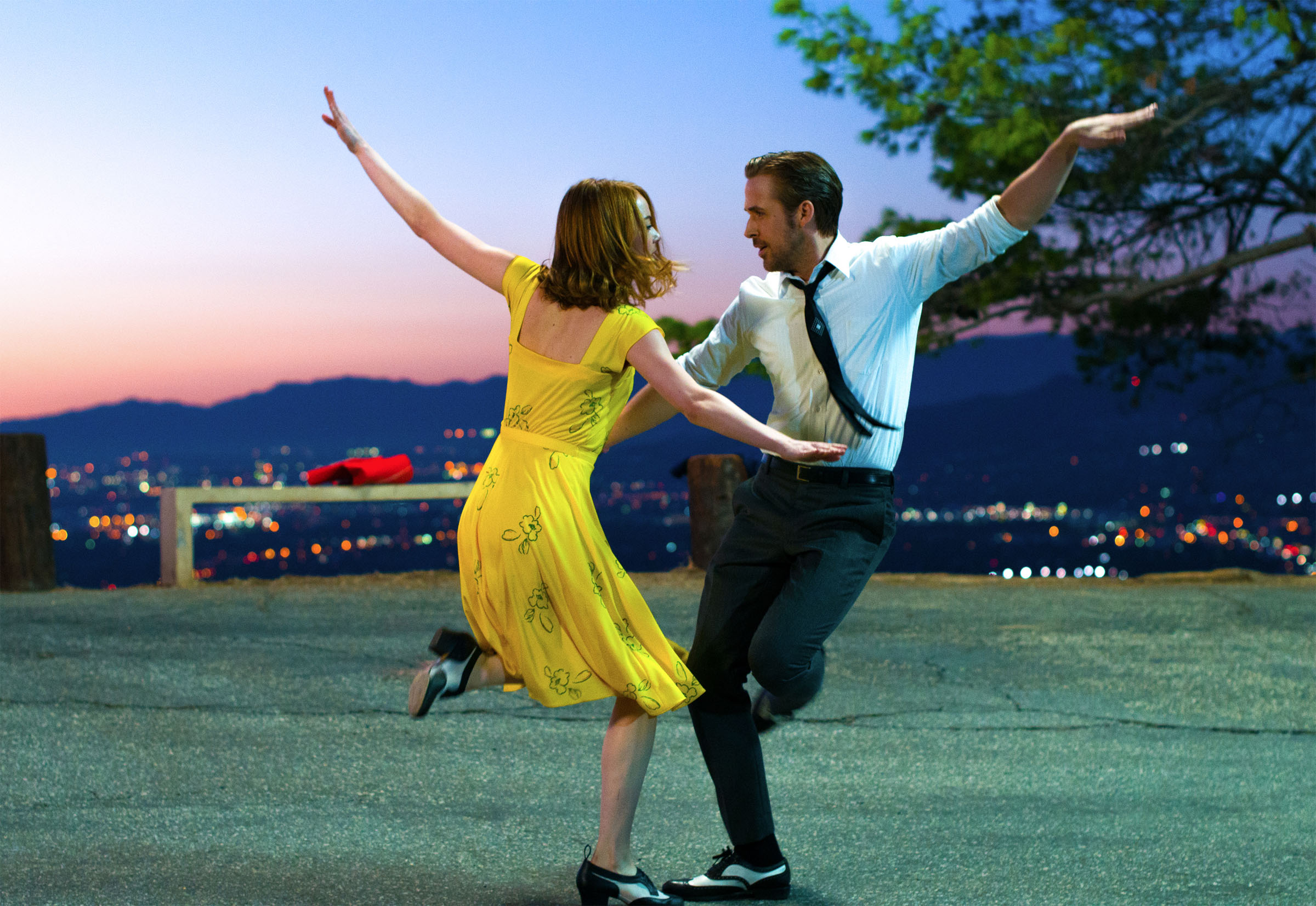La La Land (2016, Dir. Damien Chazelle):
“There’s something to be said for having even unrealistic dreams. Even if the dreams don’t come true – that to me is what’s beautiful about Los Angeles. It’s full of these people who have moved there to chase these dreams. A lot of those people are told by people around them that they’re crazy, or that they’re living in la la land. I wanted to make a movie that saluted them a little bit, and that kind of unrealistic state of mind.”
— Damien Chazelle
Escapism is in such short supply these days that you can’t blame audiences for latching onto a film that offers the idea of uncomplicated joys, especially a film like Damien Chazelle’s La La Land, an updated take on the grand old form of the Hollywood musical. And what professional critic could resist a film that also pays tribute to Los Angeles, the factory of movie dreams? Reviewers have piled aboard the love train, dusting off praises of the sort that are a studio marketer’s wet dream: “La La Land serves to remind us that movies can still be magical”; “It’s a movie with the potential to make lovers of us all”; “It does nothing less than jolt the movie musical to life for the 21st century.” The result? Fourteen Oscar nominations. As they say, that’s Hollywood, folks.
Suffice to say that La La Land is not built to bear the weight of all these nominations, or plaudits. But to say it’s an appealing trifle of movie is not to damn it with faint praise, because charming trifles are equally in short supply these days. Chazelle has studied up on the classics, and the references come fast and furious: Singing in the Rain, The Umbrellas of Cherbourg, Broadway Melody of 1940, and so on. Don’t go in expecting a brassy, soaring pastiche of those movies, though — these gestures toward the old musicals are counterbalanced with resolutely low-key storytelling. Knowing and naive, colorful and restrained, La La Land is a mongrel mix, but like a puppy, there’s a certain charm in the way it bumbles about.
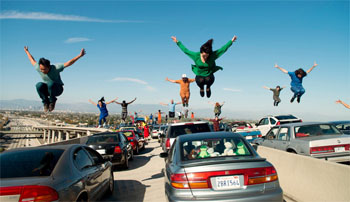 Coming out of the gates, La La Land goes heavy on homage, down to the Cinemascope logo that headlines the movie, and the first two numbers, which are as traditionally styled as it gets. The opening tune, “Another Day of Sun,” at least honors the multiculturalism of contemporary L.A.: stuck on a jammed-up freeway, performers of all shapes, colors and sizes strut their stuff. One moment we linger on the shot of a mariachi band in the back of a van; in the next skateboarders and parkour runners skid across car hoods. That’s quickly followed up by “Someone in the Crowd,” a breathless rush that takes us from the ramshackle apartment of our heroine Mia (Emma Stone) and her roommates to a house party up in the hills, as dancers strike poses and dive into pools, the camera following suit. While we can appreciate the primary colors and the fluid long takes in both songs, it’s harder to feel a sense of emotional connection. Chazelle wants to capture the buoyancy of the classics, but his cramped, medium-angle camerawork can’t match their finesse and rhythm. It doesn’t help that the lyrics by Benj Pasek and Justin Paul are short on catchy hooks — then again, it’s hard to craft hooks for characters who are barely identified, let alone defined.
Coming out of the gates, La La Land goes heavy on homage, down to the Cinemascope logo that headlines the movie, and the first two numbers, which are as traditionally styled as it gets. The opening tune, “Another Day of Sun,” at least honors the multiculturalism of contemporary L.A.: stuck on a jammed-up freeway, performers of all shapes, colors and sizes strut their stuff. One moment we linger on the shot of a mariachi band in the back of a van; in the next skateboarders and parkour runners skid across car hoods. That’s quickly followed up by “Someone in the Crowd,” a breathless rush that takes us from the ramshackle apartment of our heroine Mia (Emma Stone) and her roommates to a house party up in the hills, as dancers strike poses and dive into pools, the camera following suit. While we can appreciate the primary colors and the fluid long takes in both songs, it’s harder to feel a sense of emotional connection. Chazelle wants to capture the buoyancy of the classics, but his cramped, medium-angle camerawork can’t match their finesse and rhythm. It doesn’t help that the lyrics by Benj Pasek and Justin Paul are short on catchy hooks — then again, it’s hard to craft hooks for characters who are barely identified, let alone defined.
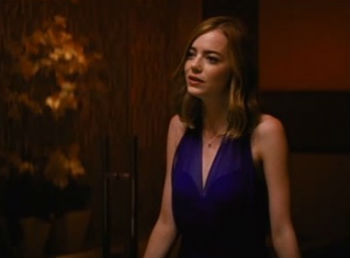 And then Emma Stone brings the hubbub to an abrupt halt. Regarding her reflection in a bathroom mirror, the soundtrack whittled down to a single piano, she sings to herself, barely above a whisper: “Is someone in the crowd the only thing you really see?” As she finds her voice, the movie finds its footing, forsaking big production numbers for matter-of-fact intimacy. Stone’s Mia is your standard unsuccessful aspiring actress (today’s audition: “Dangerous Minds meets The O.C.“), her life about to get a jolt courtesy of Sebastian (Ryan Gosling). They meet in that aforementioned freeway scene in a manner that passes for meeting cute in L.A. these days: He gives her an obnoxious honk of his horn when she dawdles in traffic, she responds by giving him the finger. Sebastian has the obstinate air of a true believer — a pianist devoted to the jazz classics, he’s committed to keeping things “pure” and nursing his dream of opening a traditional club — but he’s also a bruised romantic who suspects that his time will never come (“I’m letting life hit me until it gets tired. Then I’ll hit back. It’s a classic rope-a-dope,” he jokes).
And then Emma Stone brings the hubbub to an abrupt halt. Regarding her reflection in a bathroom mirror, the soundtrack whittled down to a single piano, she sings to herself, barely above a whisper: “Is someone in the crowd the only thing you really see?” As she finds her voice, the movie finds its footing, forsaking big production numbers for matter-of-fact intimacy. Stone’s Mia is your standard unsuccessful aspiring actress (today’s audition: “Dangerous Minds meets The O.C.“), her life about to get a jolt courtesy of Sebastian (Ryan Gosling). They meet in that aforementioned freeway scene in a manner that passes for meeting cute in L.A. these days: He gives her an obnoxious honk of his horn when she dawdles in traffic, she responds by giving him the finger. Sebastian has the obstinate air of a true believer — a pianist devoted to the jazz classics, he’s committed to keeping things “pure” and nursing his dream of opening a traditional club — but he’s also a bruised romantic who suspects that his time will never come (“I’m letting life hit me until it gets tired. Then I’ll hit back. It’s a classic rope-a-dope,” he jokes).
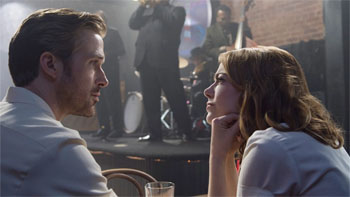 After another run-in at a pool party (he’s glumly playing keyboards for an eighties cover band; she requests Flock of Seagulls’ “I Ran” just to annoy him), the banter begins to flow. They might not have a whole lot in common, but they’re both besotted with the past. Mia lives and breathes old Hollywood: at her day job as a barrista on the Warner Brothers lot, she works across from the window where they filled the Paris scenes of Casablanca (which gives you a slight hint as to where this is all going), while at home a poster of Ingrid Bergman dominates the wall above her bed. His record collection is all vintage John Coltrane and Bill Evans, and his most prized possession is a stool that Hoagy Carmichael once sat on. Soon they find themselves perched alone above the Hollywood hills in the gloaming. It’s a perfect place for a fairy-tale romance to begin, but Seb isn’t having any of it: “Not much to look at, huh?” he cracks. Still, he slips into the soft-shoe crooner “A Lovely Night,” setting the stage for our would-be lovers to put on their dancing shoes and take wing (close your eyes and you can envision Fred Astaire and Ginger Rodgers twirling into each others’ hearts). Except they don’t, not really. Instead they work through some unassuming dance steps before wishing each other an awkward good night, and that’s after they downplay even the idea of getting together: “It’s pretty strange that we keep running into each other,” she says. “Maybe it means something,” he responds. “I doubt it,” she shoots back. “Yeah, I didn’t think so,” he agrees.
After another run-in at a pool party (he’s glumly playing keyboards for an eighties cover band; she requests Flock of Seagulls’ “I Ran” just to annoy him), the banter begins to flow. They might not have a whole lot in common, but they’re both besotted with the past. Mia lives and breathes old Hollywood: at her day job as a barrista on the Warner Brothers lot, she works across from the window where they filled the Paris scenes of Casablanca (which gives you a slight hint as to where this is all going), while at home a poster of Ingrid Bergman dominates the wall above her bed. His record collection is all vintage John Coltrane and Bill Evans, and his most prized possession is a stool that Hoagy Carmichael once sat on. Soon they find themselves perched alone above the Hollywood hills in the gloaming. It’s a perfect place for a fairy-tale romance to begin, but Seb isn’t having any of it: “Not much to look at, huh?” he cracks. Still, he slips into the soft-shoe crooner “A Lovely Night,” setting the stage for our would-be lovers to put on their dancing shoes and take wing (close your eyes and you can envision Fred Astaire and Ginger Rodgers twirling into each others’ hearts). Except they don’t, not really. Instead they work through some unassuming dance steps before wishing each other an awkward good night, and that’s after they downplay even the idea of getting together: “It’s pretty strange that we keep running into each other,” she says. “Maybe it means something,” he responds. “I doubt it,” she shoots back. “Yeah, I didn’t think so,” he agrees.
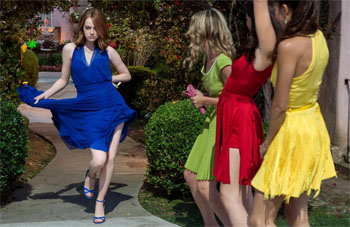 That tug-of-war between nostalgia and cynicism, stylization and reality, persists through the rest of the film. Every dreamy close-up of Stone and Gosling is counterbalanced by the sights of beat-up bungalows and clinical audition rooms, and the outside world continually intrudes on their shared reverie, whether it’s a stray car horn, a smoke alarm, or an ill-timed cell phone ringtone. Nevertheless, it’s no spoiler to say that Mia and Seb eventually find their way to each other (at a movie theater showing an old print of Rebel Without a Cause, naturally), before they finally take literal flight (thanks to a fantastical sequence at the Griffith Observatory overstuffed with special effects). The film’s sole element of suspense (such as it is) lies in the question of whether their professional trials will overwhelm their burgeoning relationship. As a piece of dramaturgy, La La Land is pretty half-baked: “Boy meets girl, boy might lose girl” is about as deep as it gets. This isn’t necessarily a fatal flaw — plenty of musicals have gotten by on a sliver of plot — but Chazelle isn’t interested in giving Mia and Seb’s lives much flavor. Save for Seb’s musician buddy Keith (John Legend, who shouldn’t quit his day job), who offers Seb a chance to fulfill his dreams by “selling out” and joining his pop-funk group, none of the other supporting characters are allowed to stick around, let alone add counterpoint and color to the story. Blink and you’ll miss Rosemarie DeWitt as Seb’s disapproving sister and Finn Wittrock as Mia’s drippy, soon-to-be ex-boyfriend. What about Mia’s rowdy, stardom-obsessed roommates? Say farewell to them after that opening number at the party. For a film titled La La Land, the movie is surprisingly barren of human life outside our two leads; Los Angeles and its inhabitants have little importance besides being a backdrop for our star-crossed lovers.
That tug-of-war between nostalgia and cynicism, stylization and reality, persists through the rest of the film. Every dreamy close-up of Stone and Gosling is counterbalanced by the sights of beat-up bungalows and clinical audition rooms, and the outside world continually intrudes on their shared reverie, whether it’s a stray car horn, a smoke alarm, or an ill-timed cell phone ringtone. Nevertheless, it’s no spoiler to say that Mia and Seb eventually find their way to each other (at a movie theater showing an old print of Rebel Without a Cause, naturally), before they finally take literal flight (thanks to a fantastical sequence at the Griffith Observatory overstuffed with special effects). The film’s sole element of suspense (such as it is) lies in the question of whether their professional trials will overwhelm their burgeoning relationship. As a piece of dramaturgy, La La Land is pretty half-baked: “Boy meets girl, boy might lose girl” is about as deep as it gets. This isn’t necessarily a fatal flaw — plenty of musicals have gotten by on a sliver of plot — but Chazelle isn’t interested in giving Mia and Seb’s lives much flavor. Save for Seb’s musician buddy Keith (John Legend, who shouldn’t quit his day job), who offers Seb a chance to fulfill his dreams by “selling out” and joining his pop-funk group, none of the other supporting characters are allowed to stick around, let alone add counterpoint and color to the story. Blink and you’ll miss Rosemarie DeWitt as Seb’s disapproving sister and Finn Wittrock as Mia’s drippy, soon-to-be ex-boyfriend. What about Mia’s rowdy, stardom-obsessed roommates? Say farewell to them after that opening number at the party. For a film titled La La Land, the movie is surprisingly barren of human life outside our two leads; Los Angeles and its inhabitants have little importance besides being a backdrop for our star-crossed lovers.
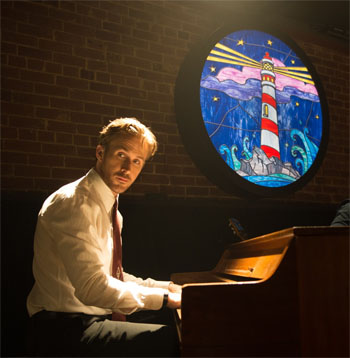 Mia: It feels really nostalgic to me.
Mia: It feels really nostalgic to me.
Sebastian: That’s the point!
Mia: Are people going to like it?
Sebastian: Fuck ’em!
More than anything else, the film’s point of view is locked inside Sebastian’s head. He bears a close resemblance to the jazz-obsessed protagonist from Chazelle’s previous film, the Oscar-nominated Whiplash — both have a blinkered view of the art form (Seb’s musical education seems to have stopped at fifties bebop) that may not match up with any enlightened critical views. “They always say, ‘Let [jazz] die.’ Not on my watch,” Sebastian harumphs at one point, opening the film up to criticism about racial undertones (leave it to the white guy to anoint himself the savior of jazz) as well as shallow representations of what jazz is about. It’s the price Chazelle must pay for setting the film in a naturalistic context, but in truth, “jazz” in this film is meant to be taken about as literally as Paris in An American in Paris, or Oklahoma frontier life in Oklahoma! The real point of the narrative is Seb’s commitment to his ideals, and how they get bent out of shape by the necessities of getting by, and making compromises. “How are you gonna be a revolutionary if you’re such a traditionalist?” Keith challenges him, but it’s clear whose side the movie is on (hint: it’s not the guy who creates the inoffensive pop confections). Mia’s character is even sketchier — apart from a self-written solo performance piece that she hopes will gain her notice (and which we never actually witness, because that would require some screenwriting ingenuity), what you see is what you get: a sassy would-be starlet undergoing a crisis of confidence. Instead of upping the ante, the film chooses self-deprecation at every turn. Gosling and Stone sing and dance in affect-free fashion, and every time you expect things to pick up, we stay earthbound. Even the musical centerpiece turns out to be a dirge-like ditty titled “City of Stars,” in which hope is knocked down to a mere tremor: “Are you shining just for me?” It’s just as well that the film keeps to the down-low, because almost every time it aims for something bolder, the results are underwhelming, such as Mia’s stab at a show-stopping moment, “Audition.” Filmed in a halo of a spotlight, it should be a major moment of self-revelation but can’t rise above Hallmark sentiment: “Here’s to the ones that dream / foolish as they may seem.”
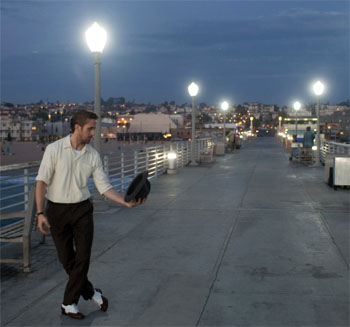 With neither the musical nor story backbone to withstand much scrutiny, La La Land should be a curio like Woody Allen’s Everyone Says I Love You, which also utilized thespians in place of musical stars, at the service of a by-the-numbers plot. The reason it isn’t is Stone and Gosling. Keeping it real while radiating a movie-star glow, they elevate the proceedings through sheer charisma. Stone could have easily stepped out of the fifties, flouncing about in a variety of starburst-colored dresses, yet her quick-trigger spontaneity is of this moment. She’s too lively a presence to let her wisp of a character hold her down. Gosling has the more difficult task: most of the time he’s required to be reactive, when he’s not pontificating about the glories of jazz. His willful self-containment prevents Seb from becoming a caricature, and when Stone drives him to exasperation or affection, the sparks between them are palpable. The movie’s best moments are grounded in restraint: Gosling getting his Chet Baker on as he wanders the pier alone, or Stone and Gosling at a piano, chuckling their way through “City of Stars.” Try as Chazelle might to present Hollywood in modern tones, the film still boils down to a hoary love story between two pretty misfits, set in a City of Angels where no obstacle to success can withstand gumption and hard work for too long. Stone and Gosling’s chemistry succeeds at making that notion palatable, even as the rest of the film strains to be clever.
With neither the musical nor story backbone to withstand much scrutiny, La La Land should be a curio like Woody Allen’s Everyone Says I Love You, which also utilized thespians in place of musical stars, at the service of a by-the-numbers plot. The reason it isn’t is Stone and Gosling. Keeping it real while radiating a movie-star glow, they elevate the proceedings through sheer charisma. Stone could have easily stepped out of the fifties, flouncing about in a variety of starburst-colored dresses, yet her quick-trigger spontaneity is of this moment. She’s too lively a presence to let her wisp of a character hold her down. Gosling has the more difficult task: most of the time he’s required to be reactive, when he’s not pontificating about the glories of jazz. His willful self-containment prevents Seb from becoming a caricature, and when Stone drives him to exasperation or affection, the sparks between them are palpable. The movie’s best moments are grounded in restraint: Gosling getting his Chet Baker on as he wanders the pier alone, or Stone and Gosling at a piano, chuckling their way through “City of Stars.” Try as Chazelle might to present Hollywood in modern tones, the film still boils down to a hoary love story between two pretty misfits, set in a City of Angels where no obstacle to success can withstand gumption and hard work for too long. Stone and Gosling’s chemistry succeeds at making that notion palatable, even as the rest of the film strains to be clever.
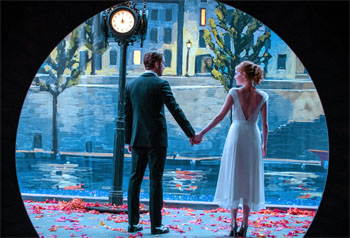 Give Chazelle credit, though — he wants to have his cake and eat it, and he does so with a final bittersweet fantasia that borrows its emotional hook from Umbrellas of Cherbourg and its look from An American in Paris (even transporting us to a storybook version of Paris), with our two lovers allowed a final twirl under the spotlights. For all the self-reflexivity on display, the film is at its most entrancing when it lets Stone and Gosling bask in each other’s company in moments like these, while Justin Hurwitz’s music, freed from the burden of lyrics, swoons along with them in waltz time. As callow as the story and characters are, we all remain susceptible to the lure of a Hollywood ending, and even as that wish is defeated by the melancholy of the here and now, we’re still allowed a last exchanged smile between our lovers. “That’s L.A.,” Seb sighs at one point. “They worship everything and they value nothing.” La La Land is a heap of nothing that still entertains because it acknowledges that in the real la la land, it’s still possible to turn nothing into something.
Give Chazelle credit, though — he wants to have his cake and eat it, and he does so with a final bittersweet fantasia that borrows its emotional hook from Umbrellas of Cherbourg and its look from An American in Paris (even transporting us to a storybook version of Paris), with our two lovers allowed a final twirl under the spotlights. For all the self-reflexivity on display, the film is at its most entrancing when it lets Stone and Gosling bask in each other’s company in moments like these, while Justin Hurwitz’s music, freed from the burden of lyrics, swoons along with them in waltz time. As callow as the story and characters are, we all remain susceptible to the lure of a Hollywood ending, and even as that wish is defeated by the melancholy of the here and now, we’re still allowed a last exchanged smile between our lovers. “That’s L.A.,” Seb sighs at one point. “They worship everything and they value nothing.” La La Land is a heap of nothing that still entertains because it acknowledges that in the real la la land, it’s still possible to turn nothing into something.

